Please wait while we process your payment
If you don't see it, please check your spam folder. Sometimes it can end up there.
If you don't see it, please check your spam folder. Sometimes it can end up there.
Please wait while we process your payment
Get instant, ad-free access to our grade-boosting study tools with a 7-day free trial!
Learn more



This site is protected by reCAPTCHA and the Google Privacy Policy and Terms of Service apply.
Create Account
Select Plan
Payment Info
Start 7-Day Free Trial!

Annual
2-49 accounts
$22.49/year + tax
50-99 accounts
$20.99/year + tax
Select Quantity
Price per seat
$29.99 $--.--
Subtotal
$-.--
Want 100 or more? Request a customized plan
You could save over 50%
by choosing an Annual Plan!

SAVE OVER 50%
compared to the monthly price!
| Focused-studying | ||
| PLUS Study Tools | ||
| AP® Test Prep PLUS | ||
| My PLUS Activity | ||
$22.49/month + tax
Save 25%
on 2-49 accounts
$20.99/month + tax
Save 30%
on 50-99 accounts
| Focused-studying | ||
| PLUS Study Tools | ||
| AP® Test Prep PLUS | ||
| My PLUS Activity | ||
No Fear provides access to Shakespeare for students who normally couldn’t (or wouldn’t) read his plays. It’s also a very useful tool when trying to explain Shakespeare’s wordplay!
Erika M.
I tutor high school students in a variety of subjects. Having access to the literature translations helps me to stay informed about the various assignments. Your summaries and translations are invaluable.
Kathy B.
Teaching Shakespeare to today's generation can be challenging. No Fear helps a ton with understanding the crux of the text.
Kay H.
No Fear provides access to Shakespeare for students who normally couldn’t (or wouldn’t) read his plays. It’s also a very useful tool when trying to explain Shakespeare’s wordplay!
Erika M.
I tutor high school students in a variety of subjects. Having access to the literature translations helps me to stay informed about the various assignments. Your summaries and translations are invaluable.
Kathy B.
Teaching Shakespeare to today's generation can be challenging. No Fear helps a ton with understanding the crux of the text.
Kay H.
Create Account
Select Plan
Payment Info
Start 7-Day Free Trial!
You will only be charged after the completion of the 7-day free trial.
If you cancel your account before the free trial is over, you will not be charged.
You will only be charged after the completion of the 7-day free trial. If you cancel your account before the free trial is over, you will not be charged.
Order Summary
Annual
7-day Free Trial
SparkNotes PLUS
$29.99 / year
Annual
Quantity
51
PLUS Group Discount
$29.99 $29.99 / seat
Tax
$0.00
SPARK25
-$1.25
25% Off
Total billed on Nov 7, 2024 after 7-day free trail
$29.99
Total billed
$0.00
Due Today
$0.00
Promo code
This is not a valid promo code
Card Details
By placing your order you agree to our terms of service and privacy policy.
By saving your payment information you allow SparkNotes to charge you for future payments in accordance with their terms.
Powered by stripe
Legal
Google pay.......



Please wait while we process your payment

Sorry, you must enter a valid email address
By entering an email, you agree to our privacy policy.
Please wait while we process your payment

Sorry, you must enter a valid email address
By entering an email, you agree to our privacy policy.
Please wait while we process your payment

Your PLUS subscription has expired
Please wait while we process your payment
Please wait while we process your payment

Graphing Inequalities on a Number Line
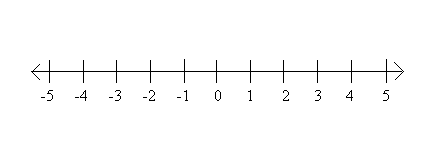
We can graph real numbers by representing them as points on the number
line. For example, we can graph "2 " on the number
line:
" on the number
line:
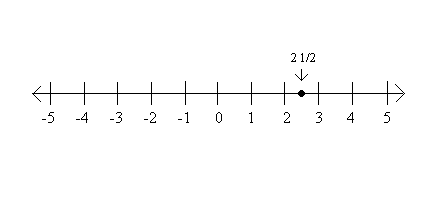

We can also graph inequalities on the number line. The following graph
represents the inequality x≤2 . The dark line
represents all the numbers that satisfy x≤2
. The dark line
represents all the numbers that satisfy x≤2 . If we
pick any number on the dark line and plug it in for x, the inequality
will be true.
. If we
pick any number on the dark line and plug it in for x, the inequality
will be true.
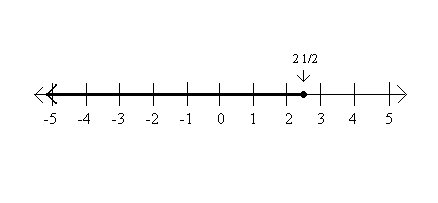

The following graph represents the inequality x < 2 . Note
that the open circle on 2
. Note
that the open circle on 2 shows that 2 is not a
solution to x < 2
shows that 2 is not a
solution to x < 2 .
.
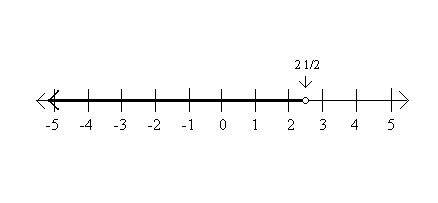

Here are the graphs of x > 2 and x≥2
and x≥2 ,
respectively:
,
respectively:
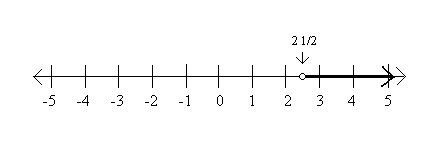



An inequality with a "≠" sign has a solution set which is all the
real numbers except a single point (or a number of single points).
Thus, to graph an inequality with a "≠" sign, graph the entire
line with one point removed. For example, the graph of x≠2 looks like:
looks like:
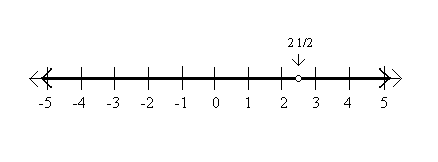

We can use the number line to solve inequalities containing <, ≤, >, and ≥. To solve an inequality using the number line, change the inequality sign to an equal sign, and solve the equation. Then graph the point on the number line (graph it as an open circle if the original inequality was "<" or ">"). The number line should now be divided into 2 regions -- one to the left of the point and one to the right of the point
Next, pick a point in each region and "test" it -- see if it satisfies the inequality when plugged in for the variable. If it satisfies the inequality, draw a dark line from the point into that region, with an arrow at the end. This is the solution set to the equation: if one point in the region satisfies the inequality, the entire region will satisfy the inequality.
Example: -3(x - 2)≤12
Solve -3(x - 2) = 12:
x - 2 = - 4Graph x = - 2, using a filled circle because the original inequality was ≤:
x = - 2
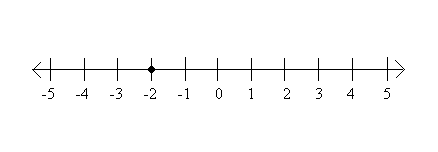
Pick a point on the left of -2 (-3, for example):Draw a dark line from -2 extending to the right, with an arrow at the end:
-3(- 3 - 2)≤12 ?
15≤12 ? No.
Pick a point on the right of -2 (0, for example):
-3(0 - 2)≤12 ?
6≤12 ? Yes.
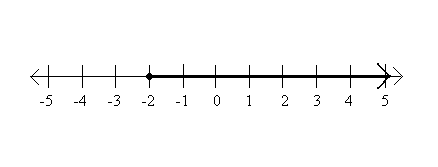
Please wait while we process your payment





